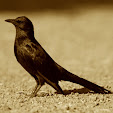 |
| The view from the fly camp on the Luvuvhu River |
This was my fourth trail in the park and the second time doing the Nyalaland Wilderness Trail in the far north. Not that any trail is really the same twice even though the drill is roughly the same. You spend three nights in the bush with two rangers looking after you and a cook who keeps you well fed. You sleep in tents or huts in proper beds with sheets and blankets. Ablutions might be basic but you'll get a hot shower after your exertions.
 |
| Our tent was between an appleleaf and leadwood tree. |
There is a chance of encountering dangerous animals, but for the most part it's about the little things - the birds, the bugs, the bush. We learnt about the intricacies of dung beetles, termite mounds and what a civet's midden looks like, among other things.
The previous time I'd been on the Nyalaland Trail, the camp was located away from the river around a giant baobab. A few years ago, this camp was flooded and so the present camp is a fly camp on the bank of the Luvuvhu River, west of Punda Maria. You know it's awesome when everyone on the back of the game vehicle bursts into spontaneous applause as you arrive at your destination. And for that extra little frisson, this camp was unfenced.
Our first night out we were treated to a display of fireflies flitting over the river. One even landed on my arm as we ate our dinner.
 |
| Leopard spoor was a regular sighting. |
 |
| One of our party quickly rustled up a water colour of the view from our camp. |
 |
| On one evening walk, we were lucky enough to observe a herd of buffalo coming down to the river to drink. |
 |
| The buffalo were on the far side of the river but nevertheless pretty nervous of us and soon pushed off in a cloud of dust. |
 |
| We were served a hearty brunches and even heartier suppers by Winston Hlungwani, son of the late Thomas Hlungwani who was the chef when I last did the Nyalaland trail. |
 |
| Because you are on a wilderness trail, your rangers can take you on roads that are otherwise not open to the public. The Punda Maria area is known for its spectacular trees. |
 |
| Among the magnificent trees of the area are many baobabs. |
 |
| A golden orb spider with her elaborate larder was another opportunity to learn about the intricacies of nature. |
Book a trail
There are eight wilderness trails in the Kruger, each as different as the next, and some more popular than others. Nyalaland is in a really scenic part of the park but is not known for its lions. This is rather elephant and buffalo country. For more information on the trails, visit the Kruger's activity link on the SANParks website.





